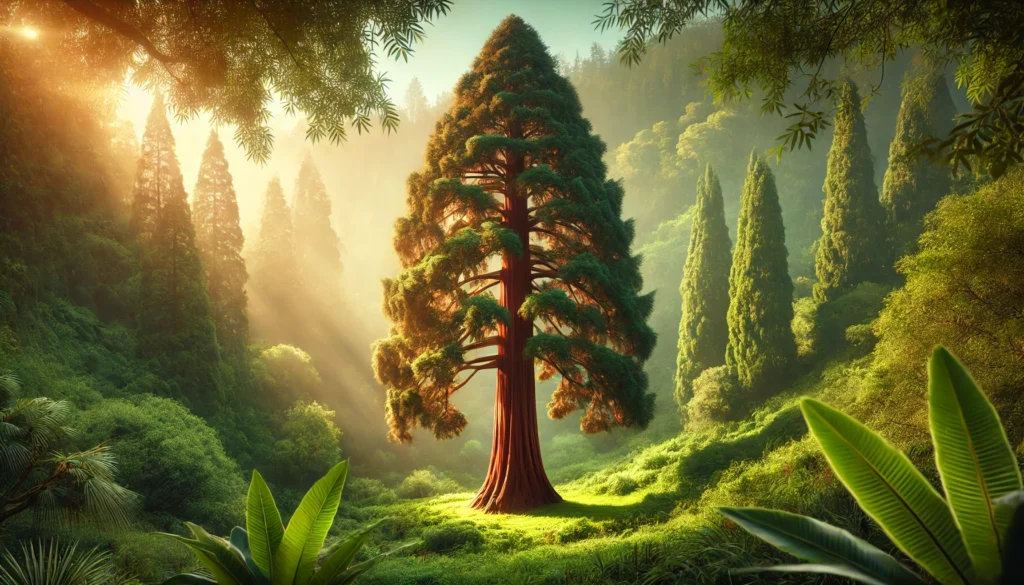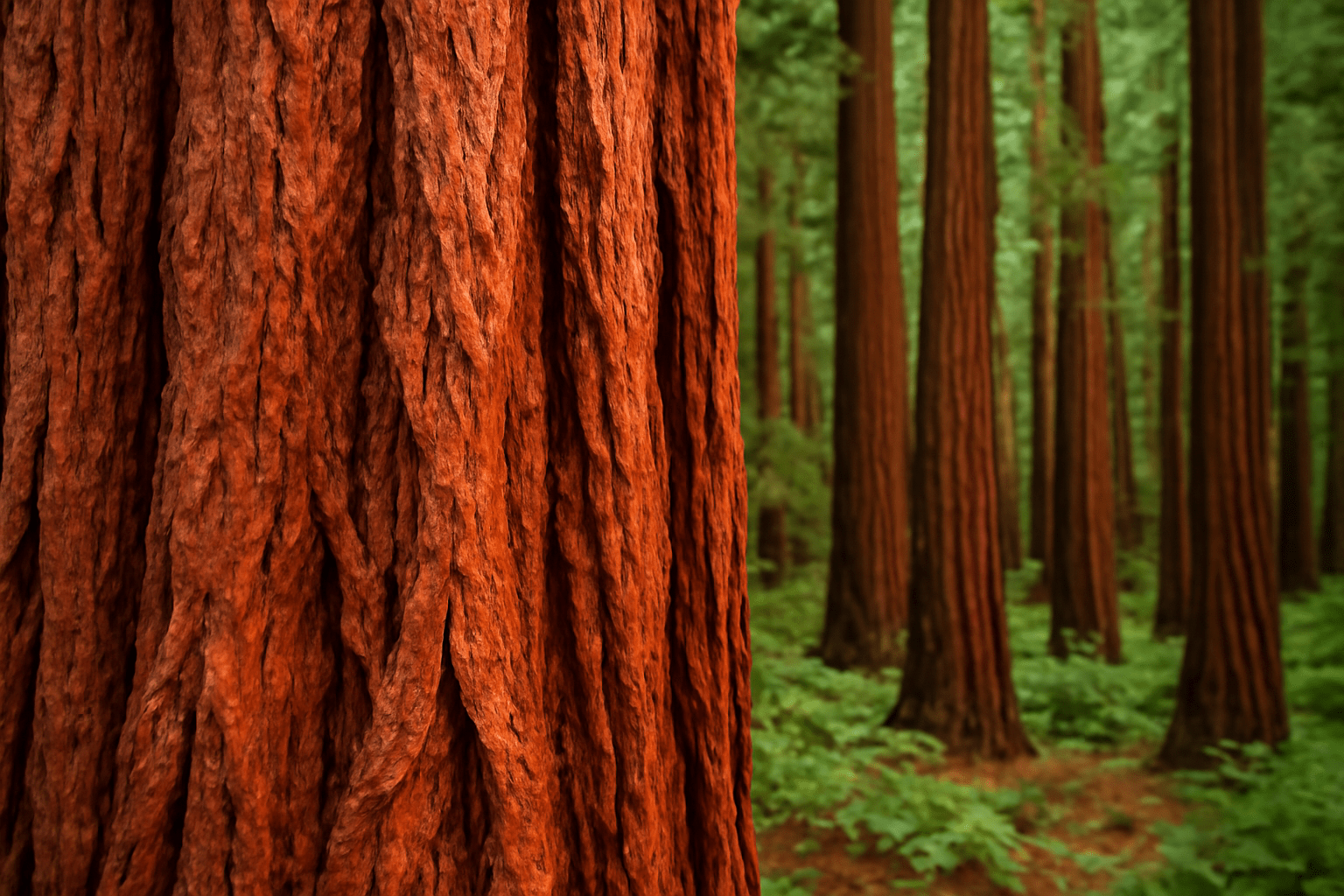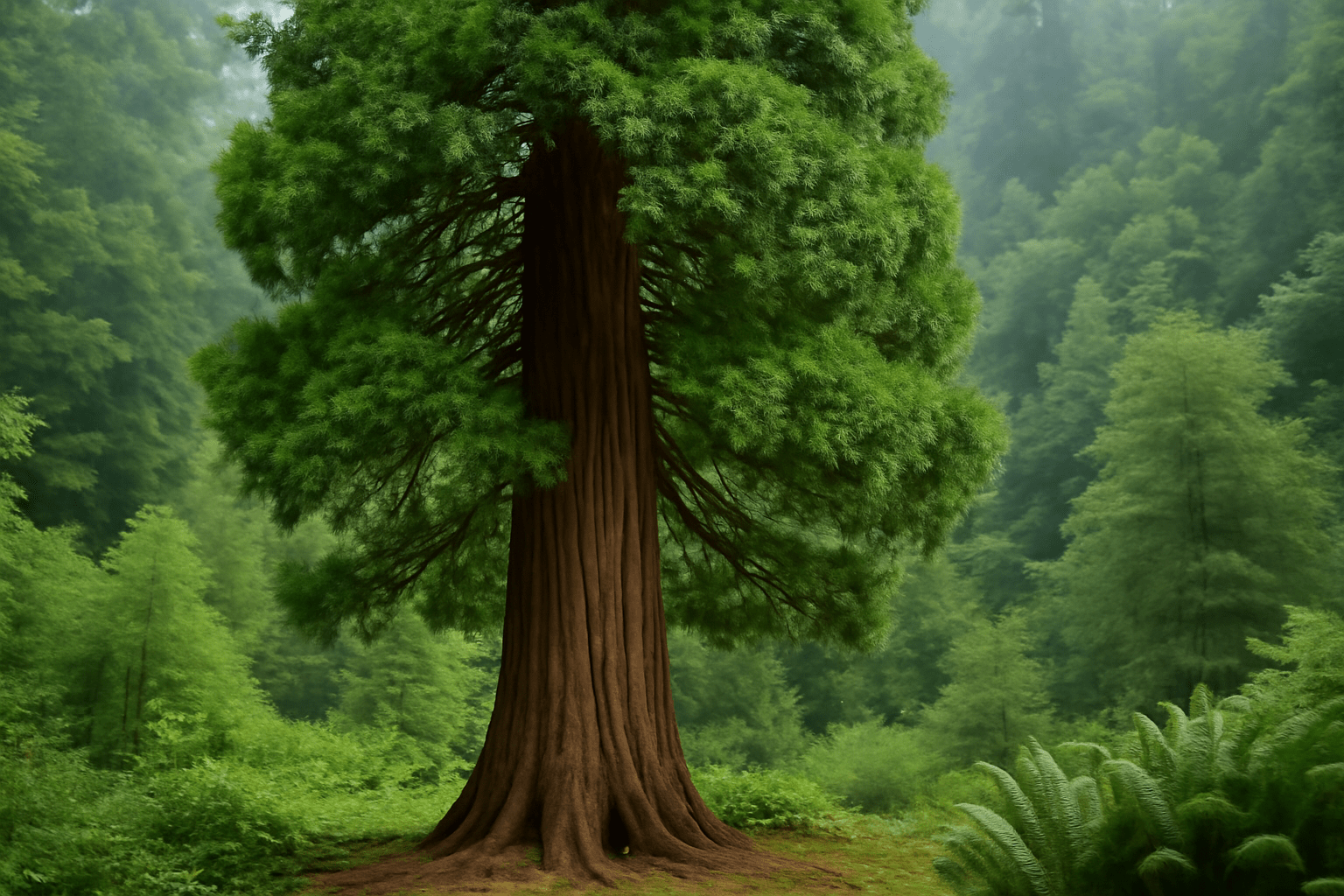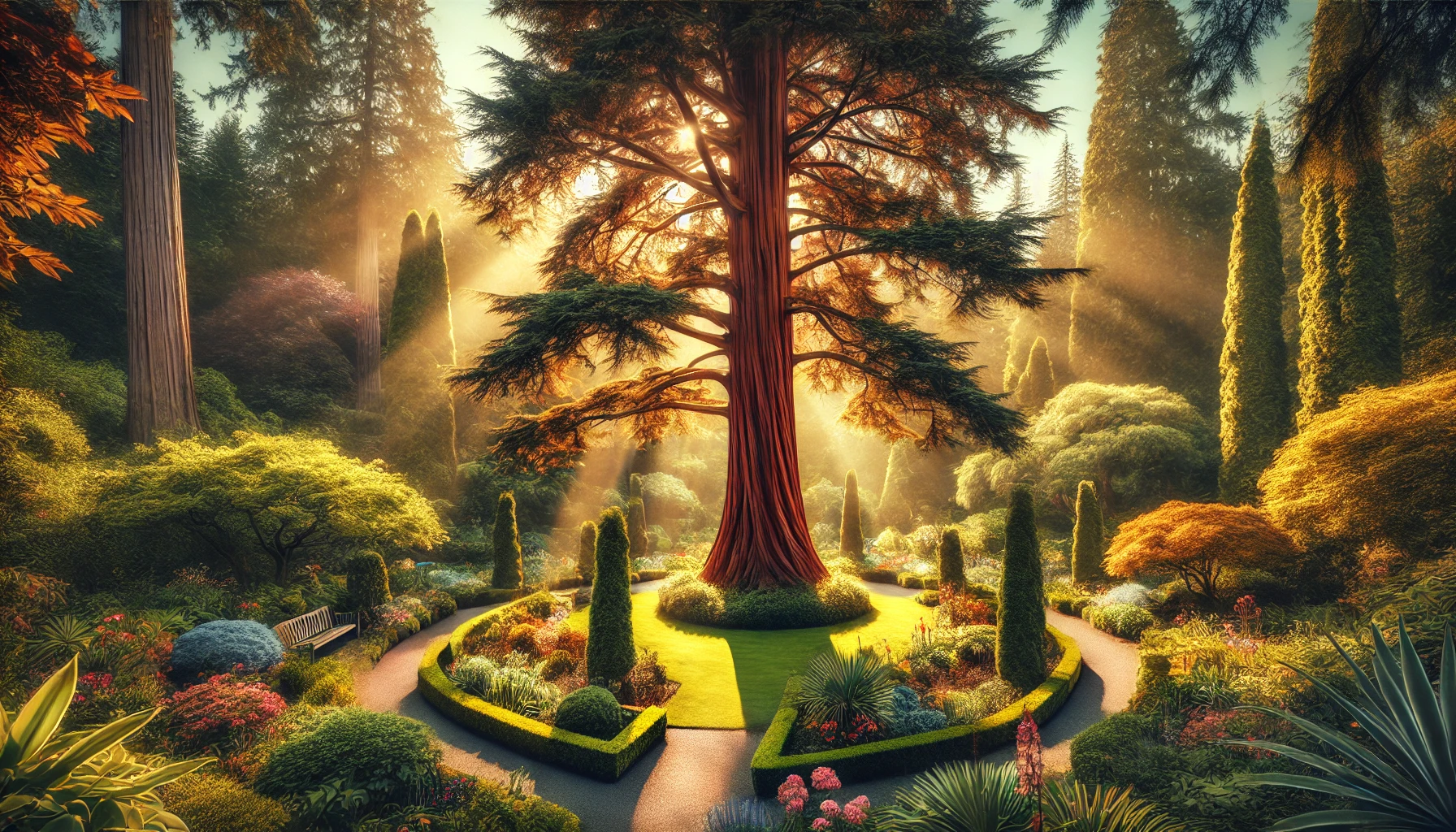
Redwood Cedar: Complete Guide to Planting, Care, and Maintenance Tips
Looking to add a majestic, low-maintenance tree to your landscape? 
In this complete guide, we’ll walk you through everything you need to know about planting, caring for, and maintaining a Redwood Cedar. From ideal planting conditions to essential maintenance tips, we’ve got you covered to ensure your tree thrives for years to come. Let’s dive into the world of Redwood Cedar and make your planting journey a success!
Table of Contents
ToggleWhat is Redwood Cedar? 
Redwood cedar is a type of evergreen tree that belongs to the Cupressaceae family. While it may sound like two separate species, “Redwood” and “Cedar” are often confused due to their similar names and shared characteristics. In reality, Redwood refers specifically to the giant redwood trees (Sequoia sempervirens) found in coastal regions of Northern California, while Cedar typically refers to trees in the Cedrus genus. However, Redwood Cedar can also refer to the hybrid term used to describe the beauty and functionality of both types of trees, especially when considering wood properties like durability and resistance to decay.

Key Features of Redwood Cedar 
- Height & Size: Redwoods are among the tallest trees in the world, with some reaching over 350 feet (107 meters). Their impressive size makes them a striking addition to any landscape.
- Durability: Known for its natural resistance to moisture, decay, and insects, Redwood cedar is a popular choice for construction, furniture, and outdoor projects. This makes it an excellent option for decking, fences, and siding.
- Aesthetic Appeal: The rich reddish-brown color of Redwood cedar adds warmth and a natural, timeless look to your yard or home. Over time, it can develop a graceful silver patina if left untreated.
- Low Maintenance: Thanks to its resilience, Redwood cedar requires less maintenance than many other woods. You won’t need to worry about frequent painting or staining.
- Eco-friendly: Being a renewable resource, Redwood cedar is a sustainable choice for those looking to incorporate more eco-friendly materials into their projects. Plus, these trees help sequester carbon, contributing to a healthier planet
.

Whether you’re looking to plant a majestic tree or use its wood for construction, Redwood cedar offers a perfect blend of beauty, function, and durability.
Ideal Conditions for Planting Redwood Cedar 
Redwood Cedars are beautiful, long-living trees that thrive when planted in the right conditions. To help ensure your Redwood Cedar grows strong and healthy, it’s important to understand the ideal environment for planting them. Here are some key factors to consider:
1. Choose the Right Location 
Redwood Cedars prefer a spot with full sun to partial shade. While they can tolerate some shade, they do best when exposed to plenty of sunlight, especially during the early years of growth. Make sure the spot is not too shaded by other trees or structures.
2. Well-Draining Soil 
Good drainage is crucial! Redwood Cedars don’t like sitting in waterlogged soil. Aim for moist, well-drained soil that is slightly acidic to neutral (pH of 6.0 to 7.0). If your soil tends to stay too wet, consider adding compost or organic matter to improve drainage.

3. Space to Grow 
These trees can grow very large, so give them plenty of space to spread their roots and branches. A distance of at least 15-20 feet from other trees or buildings is ideal. This will allow your Redwood Cedar to develop properly without competition for water or nutrients.
4. Moderate Temperatures 
Redwood Cedars thrive in temperate climates with moderate temperatures. They are especially suited to regions with mild winters and cool, foggy summers. If you live in an area with extreme temperatures, ensure the tree is well-protected from wind or heat stress.
5. Watering Needs 
Redwoods like consistent moisture, especially in their early years. Be sure to water them regularly, particularly during dry spells, but avoid over-watering, which can lead to root rot. Mulching around the base can help retain moisture and protect the roots.
6. Avoid Strong Winds 
While Redwood Cedars are tough, they can be vulnerable to strong winds. If you’re planting in an area with frequent gusts, consider planting the tree near a windbreak, such as a fence or another structure, to help protect it.
7. Frost Protection 
Redwood Cedars are relatively cold-hardy, but they may struggle in areas with harsh winter frosts. If you live in a region prone to freezing temperatures, consider planting your tree in a sheltered spot, or use frost covers during the coldest months.
By choosing the right spot and following these simple guidelines, you can create the perfect environment for your Redwood Cedar to grow and thrive for years to come!
How to Plant Redwood Cedar Trees
Planting Redwood Cedar trees is an exciting and rewarding project! These majestic trees can transform your landscape and thrive with a little know-how. Whether you’re a beginner or have some gardening experience, here’s a simple, step-by-step guide to help you plant and grow your own redwood cedar trees.
1. Choose the Right Location 
Redwood Cedar trees need plenty of space to grow tall and wide. Choose a spot that has:
- Full sun: They thrive in direct sunlight, so make sure your spot gets at least 6-8 hours of sunlight each day.
- Well-drained soil: They prefer soil that drains well but stays moist. Avoid areas where water pools.
- Space to grow: These trees can reach impressive heights (over 100 feet in some cases!), so give them enough space to spread their roots and branches.
2. Prepare the Soil 
The soil plays a crucial role in your tree’s success. Here’s how to prepare it:
- Loosen the soil: Use a shovel or garden fork to loosen the soil in the planting area. This helps the roots establish quickly.
- Amend the soil: If your soil is heavy or clay-like, mix in some organic compost to improve drainage. Redwood Cedars prefer slightly acidic to neutral soil (pH 6.0-7.0).
- Avoid chemical fertilizers: These trees prefer natural soil nutrients, so it’s best to skip harsh chemicals.
3. Dig the Right Size Hole 
Dig a hole that is about 2-3 times the width of the tree’s root ball but only as deep as the root ball. You want the tree to sit at the same level as it was in the pot.
- Tip: If you’re planting multiple trees, space them at least 10-15 feet apart to give them room to grow.
4. Plant the Tree 
Once your hole is ready, follow these steps:
- Remove the tree from the pot: Gently slide the tree out of the pot, avoiding any damage to the roots.
- Inspect the roots: Check for any roots that are tangled or circling. If necessary, gently loosen them with your fingers or a garden knife.
- Place the tree in the hole: Position the tree in the center of the hole, ensuring the top of the root ball is level with the ground. Fill in the hole with soil, gently tamping it down as you go to eliminate air pockets.

5. Water Immediately 
After planting, give your tree a deep watering to help it settle in. Water the base of the tree, making sure the soil is moist but not soggy. Consistent watering is important, especially during the first few months as the roots establish.
- Tip: Keep the soil moist (not wet) for the first few weeks, but avoid overwatering. Too much water can cause root rot.
6. Mulch for Moisture Retention 
Add a layer of mulch around the base of the tree, about 2-3 inches thick. Mulch helps retain moisture, keeps the soil cool, and prevents weeds. Be sure to keep the mulch a few inches away from the tree’s trunk to prevent rot.
7. Monitor Growth and Health 
Redwood Cedar trees are low-maintenance, but a little attention goes a long way:
- Water regularly: During dry periods, make sure to water your tree deeply every 7-10 days.
- Fertilize sparingly: Use a slow-release, organic fertilizer once a year in spring to give your tree a nutrient boost.
- Check for pests: Although redwood cedars are resistant to pests, it’s good to inspect them regularly for any signs of trouble, like discolored needles or holes in the leaves.
Final Thoughts 
Planting a Redwood Cedar tree is a fantastic investment in your garden’s future. By choosing the right location, preparing the soil properly, and following these simple steps, you’ll have a healthy, thriving tree that adds beauty and shade to your landscape. Enjoy watching it grow and flourish!
Redwood Cedar Care and Maintenance 
Taking care of your redwood cedar tree is easy and rewarding. These majestic trees are not only beautiful but also relatively low-maintenance, making them a great addition to any garden or landscape. Here’s a simple guide to keeping your redwood cedar healthy and thriving.
1. Watering 
Watering is crucial, especially during the first few years after planting. Redwood cedars love moisture but don’t like soggy roots. Here’s the sweet spot:
- Young trees need consistent watering. Water deeply once a week during dry spells, ensuring the soil is moist but not waterlogged.
- Mature trees are more drought-tolerant but still need watering during long dry periods. Aim to water deeply once every two weeks in hot weather.
- Always water at the base of the tree, not on the foliage, to avoid fungal issues.
2. Soil Quality and Drainage 
Redwood cedars thrive in slightly acidic, well-drained soil. If your soil tends to hold water, amend it with organic matter like compost to improve drainage. You want the soil to be loose and crumbly, not compacted.
3. Mulching 
Apply a 2- to 3-inch layer of mulch around the base of the tree. Mulch helps to:
- Retain soil moisture
- Keep roots cool in summer
- Prevent weed growth
Just be sure to keep the mulch a few inches away from the trunk to prevent rot.
4. Pruning 
Pruning your redwood cedar helps maintain its shape and health. While redwood cedars don’t need heavy pruning, here’s what you can do:
- Remove dead or damaged branches to prevent disease.
- Shape the tree if you want to control its size or create a specific look, but avoid cutting too much as these trees naturally have a beautiful, free-flowing shape.
- Prune in late winter or early spring before new growth starts, to avoid stressing the tree.
5. Pest and Disease Management 
While redwood cedars are generally pest-resistant, it’s important to keep an eye out for potential issues:
- Spider mites can sometimes target cedar trees, causing the needles to turn yellow or brown. Treat with insecticidal soap or a strong water spray.
- Cedar apple rust is a fungal disease that affects both redwoods and other conifers. Keep the area around the tree clean and prune away any affected branches.
6. Fertilizing 
Fertilizing your redwood cedar can help encourage strong growth, but too much fertilizer can cause harm. Use a slow-release, balanced fertilizer once in early spring to support new growth. Avoid fertilizing in the fall, as this can encourage new growth that won’t have time to harden off before winter.
7. Winter Care 
Redwood cedars are hardy but still need protection from extreme winter conditions. To protect your tree:
- Water well before the ground freezes.
- Apply mulch to insulate the roots.
- In regions with heavy snow, you can gently shake off the snow from branches to prevent damage.
8. Troubleshooting Common Issues 
- Yellowing Needles: This could be a sign of overwatering, poor soil drainage, or a nutrient deficiency. Check the soil moisture and consider adding a balanced fertilizer.
- Brown Tips: If the tips of your cedar tree turn brown, this might be due to drought stress or damage from extreme heat. Ensure your tree is getting enough water.
By following these simple yet effective care tips, your redwood cedar tree will stay healthy, vibrant, and a stunning centerpiece in your garden. 
Common Problems and Solutions for Redwood Cedar 
Redwood Cedar trees are beautiful additions to any garden or landscape, but like all plants, they can face challenges. Here are some common issues you might encounter with these majestic trees and simple solutions to keep them healthy and thriving.
1. Yellowing Leaves 
Problem: Yellowing leaves can be a sign of several issues, from nutrient deficiencies to overwatering.
Solution:
- Nutrient Deficiency: Make sure your tree is getting enough nutrients. Apply a balanced fertilizer in the spring to boost its health.
- Watering Issues: Check if the soil is consistently too wet or too dry. Redwood Cedars prefer evenly moist soil, so adjust your watering schedule as needed.
- Drainage: Ensure the tree’s location has proper drainage to prevent root rot.

2. Brown Needle Tips 
Problem: Brown tips on the needles might indicate stress from environmental factors like heat or drought.
Solution:
- Watering: Water your tree deeply during dry spells to ensure the roots have enough moisture.
- Mulch: Add a layer of mulch around the base to help retain moisture and regulate temperature.
- Shade: If your tree is in a particularly hot spot, consider moving it to a location with more shade or adding temporary shade during extreme heat.
3. Pests 
Problem: Pests like aphids, spider mites, and scales can attack Redwood Cedars, causing damage to the foliage and branches.
Solution:
- Inspection: Regularly inspect your tree for signs of pests. If you find any, remove them by gently spraying the affected areas with water or using an insecticidal soap.
- Beneficial Insects: Introduce natural predators like ladybugs to control aphids and other pests.
4. Root Rot 
Problem: Overwatering or poor drainage can lead to root rot, which can kill your tree if not addressed.
Solution:
- Proper Watering: Water your Redwood Cedar only when the soil feels dry about 2 inches down. Avoid letting the tree sit in water.
- Improve Drainage: If your soil doesn’t drain well, consider planting your tree in a raised bed or adding sand to improve drainage.
5. Slow Growth 
Problem: If your Redwood Cedar isn’t growing as quickly as expected, it could be due to poor soil conditions, lack of sunlight, or overcrowding.
Solution:
- Soil Testing: Test the soil to ensure it’s not too acidic or lacking nutrients. Amend the soil with compost or a slow-release fertilizer if necessary.
- Sunlight: Ensure the tree is planted in a spot that receives full sunlight for at least 6 hours a day.
- Space: Make sure your tree has enough space to grow without competition from other plants.
6. Browning on Inner Branches 
Problem: If the inner branches of your Redwood Cedar are turning brown, it could be a result of natural aging or lack of sunlight.
Solution:
- Pruning: Trim back any dead or damaged branches to improve airflow and allow sunlight to reach the interior of the tree.
- Healthy Growth: Focus on keeping the outer foliage healthy, as Redwood Cedars often shed inner branches as they mature.
By addressing these common issues, you can keep your Redwood Cedar strong, healthy, and growing for years to come. If you stay proactive and mindful of their needs, these majestic trees will thrive in your landscape.
Benefits of Planting Redwood Cedar 
Planting redwood cedar trees is a fantastic choice for anyone looking to enhance their landscape while reaping numerous environmental and practical benefits. Whether you’re a gardening enthusiast or a homeowner looking for a long-lasting, beautiful addition to your yard, redwood cedars offer unique advantages. Here’s why you should consider planting them:
1. Aesthetic Appeal and Longevity 
Redwood cedars are known for their stunning, tall, and majestic appearance. With their dense foliage and graceful form, they make a striking addition to any garden or landscape. Plus, these trees can live for hundreds, even thousands, of years. If you’re looking to plant a tree that will thrive for generations, the redwood cedar is a perfect choice.
2. Privacy and Wind Protection 
One of the best features of redwood cedar trees is their ability to create natural barriers. Their dense, evergreen foliage provides excellent privacy, acting as a natural screen from prying eyes. Whether you’re looking to block out noise or create a secluded backyard oasis, redwood cedars serve as a powerful shield. They’re also fantastic windbreaks, helping to protect your home and other plants from harsh winds.
3. Environmental Benefits 
Planting redwood cedars offers significant environmental advantages. These trees are incredibly effective at absorbing carbon dioxide and other pollutants from the air, making them valuable for improving air quality. Additionally, they help conserve soil by preventing erosion with their deep root systems. As they grow, redwood cedars also provide crucial habitats for wildlife, supporting biodiversity in your local ecosystem.

4. Low Maintenance and Hardiness 
Redwood cedars are resilient and easy to care for, making them ideal for beginners. Once established, they require minimal upkeep, needing only occasional watering and pruning. Their natural resistance to pests and diseases means you won’t have to worry much about maintenance. Moreover, these trees are hardy in a variety of climates, thriving in both wet and dry conditions.
5. Increased Property Value 
A well-planted redwood cedar can boost your property’s curb appeal and overall value. Homebuyers are often drawn to properties with mature, healthy trees, as they signify a well-maintained home and provide long-term benefits. Whether you’re planning to sell or just want to enjoy your space, a redwood cedar can be a wise investment.
6. Shade and Cooling Effect 
Redwood cedars grow tall and wide, providing ample shade for your yard or garden. Their thick canopy helps reduce the amount of sunlight hitting the ground, cooling your outdoor space during hot summer days. This shade can also help lower your energy bills by reducing the heat around your home, making your living environment more comfortable and sustainable.
7. Durability and Strength 
Redwood cedar wood is prized for its strength, durability, and resistance to decay. Though you may not use the wood from your trees immediately, these traits mean that redwood cedars will remain sturdy and healthy for many years, making them an excellent long-term investment for your landscape. As the trees grow, their wood also adds a natural charm and texture to the environment.
By planting a redwood cedar, you’re not only enhancing the beauty and function of your yard but also contributing positively to the environment and your future. Whether you want privacy, natural beauty, or environmental benefits, redwood cedars deliver in abundance.
Conclusion 
The Redwood Cedar is more than just a tree—it’s an investment in beauty, shade, and long-term growth for your landscape. Whether you’re looking to add an iconic focal point to your garden or want a low-maintenance tree that stands the test of time, the Redwood Cedar is the perfect choice.

With the proper care and attention, your Redwood Cedar will grow into a majestic tree that enhances your yard for years to come. Remember, from choosing the right location to regular maintenance, this guide has provided you with everything you need to ensure your tree’s success. Start planting today, and let your Redwood Cedar become the centerpiece of your outdoor space!
Frequently Asked Questions(FAQ)
How fast does a Redwood Cedar grow?
The Redwood Cedar grows slowly, typically 1-2 feet per year. Although it takes time to reach its full height, it can live for hundreds of years, providing long-lasting beauty and shade in your landscape.
What is the best time to plant a Redwood Cedar?
The best time to plant a Redwood Cedar is during early spring or fall when the weather is mild. This gives the tree time to establish its roots before the heat of summer or the cold of winter.
How tall will my Redwood Cedar grow?
A Redwood Cedar can reach up to 200 feet tall in its natural environment. However, in residential areas, it typically grows to about 50-70 feet, depending on the available space and care.
Can I grow a Redwood Cedar in a small yard?
While Redwood Cedars are large trees, there are smaller varieties available for limited spaces. If you have a small yard, consider planting a dwarf or smaller cultivar of Redwood Cedar that suits your space.
How much sunlight does a Redwood Cedar need?
Redwood Cedars prefer full sun to partial shade. They thrive in locations where they receive at least 6 hours of direct sunlight daily, but they can tolerate some shade, especially when young.
How do I care for my Redwood Cedar tree?
To care for a Redwood Cedar, ensure it’s planted in well-drained, slightly acidic soil. Water regularly during the first few years until established. Prune occasionally to remove dead or damaged branches, and mulch around the base to retain moisture and prevent weeds.
What are common problems with Redwood Cedars?
Common problems with Redwood Cedars include yellowing leaves due to overwatering or poor drainage, as well as pest issues like scale insects or aphids. To prevent problems, make sure the tree is planted in well-drained soil and monitor for pests regularly.
Can I grow a Redwood Cedar in a pot or container?
While Redwood Cedars are typically planted in the ground due to their size, you can grow a young tree in a large container for a few years. However, as the tree matures, it will need to be transferred to the ground to allow for proper root growth and expansion.









